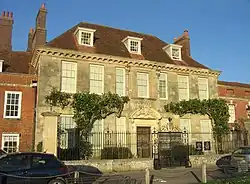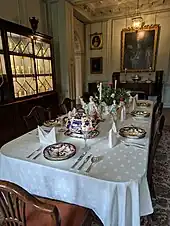Mompesson House
Mompesson House is an 18th-century house in the Cathedral Close, Salisbury, Wiltshire, England. The house is Grade I listed[1] and has been in the ownership of the National Trust since 1975.[2]
| Mompesson House | |
|---|---|
 South front | |
| Type | Mansion |
| Location | 53, The Close, Salisbury |
| Coordinates | 51°04′00″N 1°47′54″W |
| OS grid reference | SU 14228 29731 |
| Area | Wiltshire |
| Built | 1701 |
| Architectural style(s) | Queen Anne |
| Owner | National Trust |
Listed Building – Grade I | |
| Official name | Mompesson House |
| Designated | 28 February 1952 |
| Reference no. | 1355808 |
Listed Building – Grade I | |
| Official name | Screen wall, rails, piers, gates and overthrow in front of Mompesson House |
| Designated | 12 October 1972 |
| Reference no. | 1253989 |
 Location of Mompesson House in Wiltshire | |
History
The Mompesson family had lived in Wiltshire since the fifteenth century, residing in Bathampton.[3] Thomas Mompesson the elder moved to Salisbury, securing a 40-year lease on the north side of Chorister's Green in 1635 and building a large property with a hall and ten other rooms.[3] His son, Sir Thomas Mompesson, MP for the constituency of Salisbury in 1679, 1695 and 1701, rebuilt the property in the late 1670s as well as adding the adjacent stable block.[4] The site was purchased at the end of the 17th century and the house reflects the classic Queen Anne style of that period, as well as the influence of Christopher Wren.[5] It is built with ashlar Chilmark stone.[1][6] To the right of the main house stands the brick-built service building which was constructed on the site of the old Eagle Inn that closed in 1625.
Thomas's son Charles completed the building in 1701; his initials[4] and date can be seen on the heads of the water downpipes.[7] The renovations included a new stone façade, and created the building seen today.[4] In 1703 Charles commemorated his marriage to Elizabeth Longueville by adding a cartouche over the front door displaying their joined coats of arms.[8] After Charles' death in 1714, Elizabeth's brother Charles Longueville moved into the house with his widowed sister. They added the plasterwork, staircase and the brick wing in 1740.[9] After Charles Longueville's death, the house passed via his natural son, John Clark, to Mrs Thomas Hayter.[10]
Next, the house was occupied by the three Portman sisters, Ann, Wyndham and Henrietta, the daughters of Henry Portman,[11] the last of whom died at a great age in 1846.[11] The Townsend family occupied the house from 1846 to 1939, and the flamboyant artist Miss Barbara Townsend, mentioned in Edith Olivier's book Four Victorian Ladies of Wiltshire, lived there for the whole of her 96 years.[12] The Bishop of Salisbury, Neville Lovett, lived there from 1942 to 1946.[13]
In 1952 the freehold was purchased from the Church Commissioners by the architect, Denis Martineau, who bequeathed it to the National Trust on his death in 1975, a condition of the sale.[13] Martineau completed extensive repairs and renovation throughout the property and opened the home to visitors two afternoons each week.[13]
The overthrow, iron railings, gates and iron lamps at the front of the building are Grade I listed separately from the house.[14]
Collections

The house contains Georgian plasterwork and carvings of exceptional quality which have been carefully restored by the National Trust, including the removal of many layers of paint which had obscured them.[13] When the Trust inherited the house, it was empty of furnishings as Martineau had bequeathed his possessions to relatives.[13] The Trust has therefore redecorated the visitor rooms with 18th-century pieces.[13]
In keeping with the Georgian interiors, the dining room in the house is used to display the Turnbull collection of English 18th-century drinking glasses bequeathed to the Trust in 1970 by Mr. O.G.N. Turnbull.[15] The house also hosts the Bessemer-Wright collection of ceramics, bequeathed by Mrs Adam Smith,[13] which includes porcelain figures from the Derby & Bow factories, Sèvres plates and Wedgewood urns.[16]
In popular culture
Mompesson House was used as a location for the 1995 film adaptation of Sense and Sensibility.[13]
References
- Historic England. "Mompesson House (1355808)". National Heritage List for England. Retrieved 16 December 2019.
- "Mompesson House". Salisbury Cathedral Close Preservation Society. Retrieved 18 May 2013.
- Reiff 1986, p. 110.
- Reiff 1986, p. 111.
- Stratton 1920, p. 25.
- "Your Paintings". Art UK. Retrieved 18 May 2013.
- Pevsner & Cherry 2002, p. 429.
- Garnett 2008, p. 4.
- Reiff 1986, p. 113.
- Garnett 2008, p. 21.
- Garnett 2008, p. 22.
- "Salisbury Journal". Wonderful Water colours. Newsquest Southern (Ltd). Retrieved 18 May 2013.
- Garnett 2008, p. 24.
- Historic England. "Screen wall, rails, piers, gates and overthrow in front of Mompesson House (1253989)". National Heritage List for England. Retrieved 16 December 2019.
- Newby, Martine S (2006). The Turnbull collection of English 18th-Century drinking glasses. Swindon: National Trust. ISBN 1-903394-02-3.
- Garnett 2008, p. 6.
Bibliography
- Garnett, Oliver (2008). Mompesson House. Swindon: National Trust. ISBN 978-1-84359-282-2.
- Pevsner, Nikolaus; Cherry, Bridget (2002). Wiltshire. New Haven: Yale University Press. ISBN 9780300096590.
- Reiff, Daniel D. (1986). Small Georgian Houses in England and Virginia: origins and development through the 1750s. London: Associated University Presses. ISBN 0874132541.
- Stratton, Arthur (1920). The English interior, a review of the decoration of English homes from Tudor times to the XIXth century. London: B.T. Batsford.